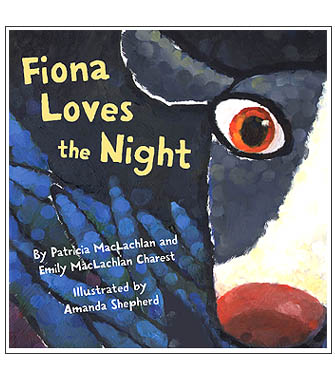|
|
|
|
||||||||||||||
|
|
|
|
|
|
|
|
||||||||||
|
|
||||||||||||||||
 |
 |
 |
|
 |
|
|
|
|
 |
|
 |
 |
Fiona Loves the Night: Creative Process The process of making a book varies from book to book. Fiona Loves the Night was a manuscript that captivated my imagination with the first word of Patricia's and Emily's story. When I recieved this manuscript it made me look out at the night sky. I looked up and the moon and stars just captivated me. It is so simple. How can we live each day and miss looking up at the night sky each night? The moon is a gift. It is so incredibly beautiful. Night is a wonderful world that reflects colors, shadows and reflections of light... it is filled with animals and flowers. In this book I wanted the reader to experience what Fiona was experiencing... each page following the first is an experience for the reader... as well as for Fiona. Book Reviews Publishers Weekly:Starred Review August 20 Awakened by moonlight streaming through the window, young Fiona slips out of her covers and into her backyard. The night wraps around her like a velvet coat,gently declare the co-authors (Charest is the Newbery Medalistıs daughter; they teamed up most recently for Once I Ate a Pie). ³It is silent. It is safe.² In simple, lyrical prose, the authors measure Fionaıs delight in the plants and creatures that come to life after the sun goes down: ³There is a moon in the middle of the pond. All around her the frogs jump into the water, making the moon wrinkle. Shepherd (previously paired with MacLachlan for Who Loves Me?) renders the night and its inhabitants in lush, comforting tones. Fingerpainted textures, applied both in strokes and in precise, printlike daubs, convey the dappling moonlight as well as the energy that makes the nocturnal world anything but sleepy. Off-kilter angles and extreme close-ups dominate the compositions, as befits the exotic setting, but the rich palette and heavy black outlines anchor the picturestheyıre dreamy rather than nightmarish. All in all, the night is a benevolent place: the moon smiles down on everything, and the creatures, like the orange-eyed barred owl that stares out of one of the pages, seem as curious about the human interloper as she is about them. Children who fear the dark could learn a lot from Fiona. Ages 4-8. (Sept.) Kirkus August 2007 ...dots of soft blues and creams create subtly luminous highlights in the nightscape, and much of what Fiona sees is rendered with larger-than-page-sized closeness. Young children, however they themselves regard the night, will feel enfolded by this nocturnal idyll School Library Journal September 2007 Through the lyrical text, children see the wonders that Fiona experiences. Shepherd places large images only partially shown against finger-painted backgrounds in shades of dark blue. Circles of color make the moon and stars soft and mysterious, and fireflies in the garden are as luminous as stars. The last spread shows Fiona and the moon looking remarkably alike. Librarians might pair Kevin Henkes Kittens First Full Moon (Greenwillow, 2004) with this story for a quiet but shining story time.BR> |
 |